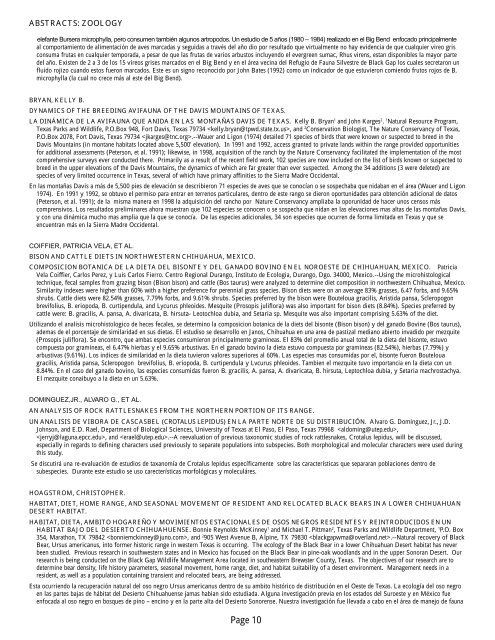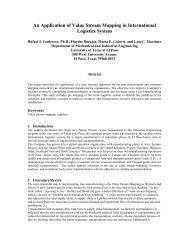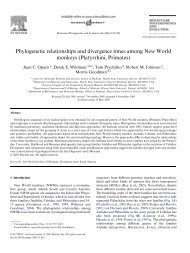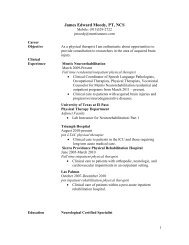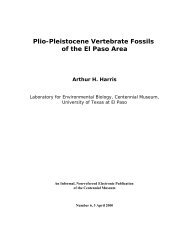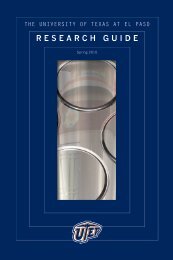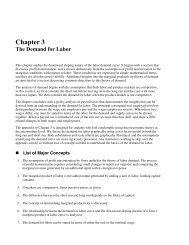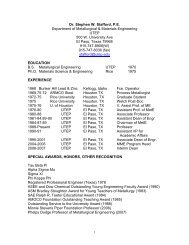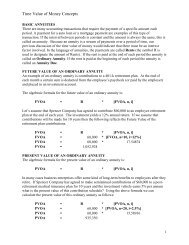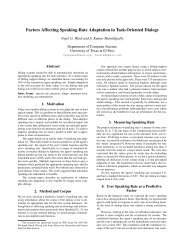Sym - Abstracts - University of Texas at El Paso
Sym - Abstracts - University of Texas at El Paso
Sym - Abstracts - University of Texas at El Paso
You also want an ePaper? Increase the reach of your titles
YUMPU automatically turns print PDFs into web optimized ePapers that Google loves.
ABSTRACTS: ZOOLOGY<br />
elefante Bursera microphylla, pero consumen también algunos artropodos. Un estudio de 5 años (1980 – 1984) realizado en el Big Bend enfocado principalmente<br />
al comportamiento de alimentación de aves marcadas y seguidas a través del año dio por resultado que virtualmente no hay evidencia de que cualquier vireo gris<br />
consuma frutas en cualquier temporada, a pesar de que las frutas de varios arbustos incluyendo el evergreen sumac, Rhus virens, estan disponibles la mayor parte<br />
del año. Existen de 2 a 3 de los 15 vireos grises marcados en el Big Bend y en el área vecina del Refugio de Fauna Silvestre de Black Gap los cuales secretaron un<br />
fluido rojizo cuando estos fueron marcados. Este es un signo reconocido por John B<strong>at</strong>es (1992) como un indicador de que estuvieron comiendo frutos rojos de B.<br />
microphylla (la cual no crece más al este del Big Bend).<br />
BRYAN, KELLY B.<br />
DYNAMICS OF THE BREEDING AVIFAUNA OF THE DAVIS MOUNTAINS OF TEXAS.<br />
LA DINÁMICA DE LA AVIFAUNA QUE ANIDA EN LAS MONTAÑAS DAVIS DE TEXAS. Kelly B. Bryan 1 and John Karges 2 . 1 N<strong>at</strong>ural Resource Program,<br />
<strong>Texas</strong> Parks and Wildlife, P.O.Box 948, Fort Davis, <strong>Texas</strong> 79734 , and 2 Conserv<strong>at</strong>ion Biologist, The N<strong>at</strong>ure Conservancy <strong>of</strong> <strong>Texas</strong>,<br />
P.O.Box 2078, Fort Davis, <strong>Texas</strong> 79734 .--Wauer and Ligon (1974) detailed 71 species <strong>of</strong> birds th<strong>at</strong> were known or suspected to breed in the<br />
Davis Mountains (in montane habit<strong>at</strong>s loc<strong>at</strong>ed above 5,500' elev<strong>at</strong>ion). In 1991 and 1992, access granted to priv<strong>at</strong>e lands within the range provided opportunities<br />
for additional assessments (Peterson, et al. 1991); likewise, in 1998, acquisition <strong>of</strong> the ranch by the N<strong>at</strong>ure Conservancy facilit<strong>at</strong>ed the implement<strong>at</strong>ion <strong>of</strong> the most<br />
comprehensive surveys ever conducted there. Primarily as a result <strong>of</strong> the recent field work, 102 species are now included on the list <strong>of</strong> birds known or suspected to<br />
breed in the upper elev<strong>at</strong>ions <strong>of</strong> the Davis Mountains, the dynamics <strong>of</strong> which are far gre<strong>at</strong>er than ever suspected. Among the 34 additions (3 were deleted) are<br />
species <strong>of</strong> very limited occurrence in <strong>Texas</strong>, several <strong>of</strong> which have primary affinities to the Sierra Madre Occidental.<br />
En las montañas Davis a más de 5,500 pies de elevación se describieron 71 especies de aves que se conocían o se sospechaba que nidaban en el área (Wauer and Ligon<br />
1974). En 1991 y 1992, se obtuvo el permiso para entrar en terrenos particulares, dentro de este rango se dieron oportunidades para obtención adicional de d<strong>at</strong>os<br />
(Peterson, et al. 1991); de la misma manera en 1998 la adquisición del rancho por N<strong>at</strong>ure Conservancy ampliaba la oporunidad de hacer unos censos más<br />
comprensivos. Los resultados preliminares ahora muestran que 102 especies se conocen o se sospecha que nidan en las elevaciones mas altas de las montañas Davis,<br />
y con una dinámica mucho mas amplia que la que se conocía. De las especies adicionales, 34 son especies que ocurren de forma limitada en <strong>Texas</strong> y que se<br />
encuentran más en la Sierra Madre Occidental.<br />
COIFFIER, PATRICIA VELA, ET AL.<br />
BISON AND CATTLE DIETS IN NORTHWESTERN CHIHUAHUA, MEXICO.<br />
COMPOSICION BOTANICA DE LA DIETA DEL BISONTE Y DEL GANADO BOVINO EN EL NOROESTE DE CHIHUAHUAN, MEXICO. P<strong>at</strong>ricia<br />
Vela Coiffier, Carlos Perez, y Luis Carlos Fierro. Centro Regional Durango, Instituto de Ecologia, Durango, Dgo. 34000, Mexico.--Using the microhistological<br />
technique, fecal samples from grazing bison (Bison bison) and c<strong>at</strong>tle (Bos taurus) were analyzed to determine diet composition in northwestern Chihuahua, Mexico.<br />
Similarity indexes were higher than 60% with a higher preference for perennial grass species. Bison diets were on an average 83% grasses, 6.47 forbs, and 9.65%<br />
shrubs. C<strong>at</strong>tle diets were 82.54% grasses, 7.79% forbs, and 9.61% shrubs. Species preferred by the bison were Bouteloua gracilis, Aristida pansa, Scleropogon<br />
brevifolius, B. eriopoda, B. curtipendula, and Lycurus phleoides. Mesquite (Prosopis juliflora) was also important for bison diets (8.84%). Species preferred by<br />
c<strong>at</strong>tle were: B. gracilis, A. pansa, A. divaric<strong>at</strong>a, B. hirsuta- Leotochloa dubia, and Setaria sp. Mesquite was also important comprising 5.63% <strong>of</strong> the diet.<br />
Utilizando el analisis microhistologico de heces fecales, se determino la composicion botanica de la diets del bisonte (Bison bison) y del ganado Bovine (Bos taurus),<br />
ademas de el porcentaje de similaridad en sus dietas. <strong>El</strong> estudiso se desarrollo en Janos, Chihuahua en una area de pastizal mediano abierto invadido per mezquite<br />
(Prosopis juliflora). Se encontro, que ambas especies consumieron principalmente gramineas. <strong>El</strong> 83% del promedio anual total de la dieta del bisonte, estuvo<br />
compuesta por gramineas, el 6.47% hierbas y el 9.65% arbustivas. En el ganado bovino la dieta estuvo compuesta por gramineas (82.54%), hierbas (7.79%) y<br />
arbustivas (9.61%). Los indices de similaridad en la dieta tuvieron valores superiores al 60%. Las especies mas consumidas por el, bisonte fueron Bouteloua<br />
gracilis, Aristida pansa, Scleropogon brevifolius, B. eriopoda, B. curtipendula y Lvcurus phleoides. Tambien el mezquite tuvo importancia en la dieta con un<br />
8.84%. En el caso del ganado bovino, las especies consumidas fueron B. gracilis, A. pansa, A. divaric<strong>at</strong>a, B. hirsuta, Leptochloa dubia, y Setaria machrostachya.<br />
<strong>El</strong> mezquite conaibuyo a la dieta en un 5.63%.<br />
DOMINGUEZ,JR., ALVARO G., ET AL.<br />
AN ANALYSIS OF ROCK RATTLESNAKES FROM THE NORTHERN PORTION OF ITS RANGE.<br />
UN ANALISIS DE VIBORA DE CASCASBEL (CROTALUS LEPIDUS) EN LA PARTE NORTE DE SU DISTRIBUCIÓN. Alvaro G. Dominguez, Jr., J.D.<br />
Johnson, and E.D. Rael, Department <strong>of</strong> Biological Sciences, <strong>University</strong> <strong>of</strong> <strong>Texas</strong> <strong>at</strong> <strong>El</strong> <strong>Paso</strong>, <strong>El</strong> <strong>Paso</strong>, <strong>Texas</strong> 79968 ,<br />
, and .--A reevalu<strong>at</strong>ion <strong>of</strong> previous taxonomic studies <strong>of</strong> rock r<strong>at</strong>tlesnakes, Crotalus lepidus, will be discussed,<br />
especially in regards to defining characters used previously to separ<strong>at</strong>e popul<strong>at</strong>ions into subspecies. Both morphological and molecular characters were used during<br />
this study.<br />
Se discutirá una re-evaluación de estudios de taxanomía de Crotalus lepidus específicamente sobre las características que separaran poblaciones dentro de<br />
subespecies. Durante este estudio se uso carecterísticas morfológicas y moleculáres.<br />
HOAGSTROM, CHRISTOPHER.<br />
HABITAT, DIET, HOME RANGE, AND SEASONAL MOVEMENT OF RESIDENT AND RELOCATED BLACK BEARS IN A LOWER CHIHUAHUAN<br />
DESERT HABITAT.<br />
HABITAT, DIETA, AMBITO HOGAREÑO Y MOVIMIENTOS ESTACIONALES DE OSOS NEGROS RESIDENTES Y REINTRODUCIDOS EN UN<br />
HABITAT BAJO DEL DESIERTO CHIHUAHUENSE. Bonnie Reynolds McKinney 1 and Michael T. Pittman 2 , <strong>Texas</strong> Parks and Wildlife Department, 1 P.O. Box<br />
354, Mar<strong>at</strong>hon, TX 79842 , and 2 905 West Avenue B, Alpine, TX 79830 .--N<strong>at</strong>ural recovery <strong>of</strong> Black<br />
Bear, Ursus americanus, into former historic range in western <strong>Texas</strong> is occurring. The ecology <strong>of</strong> the Black Bear in a lower Chihuahuan Desert habit<strong>at</strong> has never<br />
been studied. Previous research in southwestern st<strong>at</strong>es and in Mexico has focused on the Black Bear in pine-oak woodlands and in the upper Sonoran Desert. Our<br />
research is being conducted on the Black Gap Wildlife Management Area loc<strong>at</strong>ed in southeastern Brewster County, <strong>Texas</strong>. The objectives <strong>of</strong> our research are to<br />
determine bear density, life history parameters, seasonal movement, home range, diet, and habit<strong>at</strong> suitability <strong>of</strong> a desert environment. Management needs in a<br />
resident, as well as a popul<strong>at</strong>ion containing transient and reloc<strong>at</strong>ed bears, are being addressed.<br />
Esta ocurriendo la recuperación n<strong>at</strong>ural del oso negro Ursus americanus dentro de su ambito histórico de distribución en el Oeste de <strong>Texas</strong>. La ecología del oso negro<br />
en las partes bajas de hábit<strong>at</strong> del Desierto Chihuahuense jamas habian sido estudiada. Alguna investigación previa en los estados del Suroeste y en México fue<br />
enfocada al oso negro en bosques de pino – encino y en la parte alta del Desierto Sonorense. Nuestra investigación fue llevada a cabo en el área de manejo de fauna<br />
Page 10


